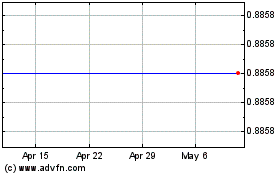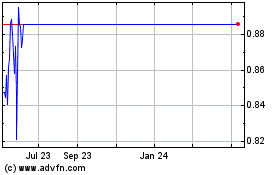Big Swiss Banks Feel the Subzero Chill -- WSJ
July 27 2016 - 3:02AM
Dow Jones News
UBS and Credit Suisse struggle as negative rates continue to
pressure earnings
By John Letzing
ZURICH -- Switzerland's biggest banks -- UBS Group AG and Credit
Suisse Group AG -- are expected to post downbeat quarterly results
later this week, as each struggle amid turbulent markets and
increasingly strict regulation.
Among the newest challenges: a tightening squeeze due to the
country's negative interest rate policy.
Negative rates aren't new in Switzerland. The Swiss National
Bank started the policy in December 2014, and in January of last
year it reduced the rate on bank deposits stored at the SNB to
-0.75%, where it has stayed since. Central banks in Japan, Denmark,
Sweden and the eurozone have also used negative rates, which may
boost growth and inflation by weakening demand for their
currencies.
In Switzerland's case, the charge only applies to reserves above
a threshold that is 20 times the minimum that the lenders are
required to hold with the central bank. In the case of UBS and
Credit Suisse, this threshold level totals about 85 billion Swiss
francs ($86.1 billion).
Data from the SNB show that sight deposits were under the
threshold, or not too far above it, for much of last year. But
sight deposits Credit Suisse and UBS hold at the SNB have surged
well past that amount in recent months, central bank data show.
They rose from 52 billion francs in December 2014 to 108.9 billion
francs last May, according to the SNB's monthly report.
As a result, the two big banks are on track to absorb a combined
amount of nearly 170 million francs in negative interest rate
charges over the course of this year if recent trends hold.
The root of the problem for both the SNB and Swiss banks,
experts said, is the relentless strength of the franc, which the
negative rates policy is designed to blunt. The SNB installed the
-0.75% deposit rate the same day, Jan. 15, 2015, that it abandoned
a ceiling on the franc's value against the euro, causing the franc
to soar.
Since then, the central bank has intervened in currency markets
to weaken the franc by buying euros and other currencies from
parties including the big banks that are major players in foreign
exchange markets -- and then crediting the banks an equivalent
amount in francs in their sight deposits.
"In many cases they're just the intermediary," Alexander Koch,
an economist at Raiffeisen Schweiz, said of the big banks. "They
have to pay the negative interest rates to the SNB, but then they
decide how to push through the costs to their clients." To date,
the major Swiss banks have only passed on the cost of negative
rates to corporate or large institutional clients, by charging them
to hold deposits.
A spokeswoman for Credit Suisse, which reports second-quarter
results on Thursday, declined to comment. And a spokesman for UBS,
which is scheduled to report earnings Friday, declined to
comment.
UBS is expected to post a significant decline in profit, while
Credit Suisse is forecast to report its third quarterly loss in a
row, amid a restructuring drive underway for nearly a year. Each
have become increasingly focused on wealth management -- a business
that can be less volatile, and less demanding of the protective
capital mandated by regulators, than investment banking.
UBS and Credit Suisse aren't alone in feeling the pain of
negative rates. Smaller Swiss bank Julius Baer Group AG's costs
tied to negative interest charged to its central bank deposits
amounted to 20 million francs during the first half of this year,
it said Monday.
Julius Baer Chief Executive Boris Collardi said much of the
problem is the allure of the local currency. "Clients continue to
be in love with the Swiss franc," he said.
Executives at UBS have been particularly vocal with their
criticism of negative rates. "Because of low and even negative
interest rates, we and the whole industry are now presented with a
frankly absurd question: do we still really want to take on client
assets when doing so costs the bank money -- and when we have to
back up liquid assets with an unreasonably large amount of
capital?" UBS Chief Executive Sergio Ermotti said in May .
Martin Lüthy, a senior lecturer at ZHAW School of Management and
Law, said it's only a matter of time until the big Swiss banks
begin expanding the range of clients that they hit with negative
interest rates. "I'd expect they'll start now with wealthy
clients," Mr. Lüthy said, "and say, if you have more than a half a
million in your account, we'll start charging."
Write to John Letzing at john.letzing@wsj.com
(END) Dow Jones Newswires
July 27, 2016 02:47 ET (06:47 GMT)
Copyright (c) 2016 Dow Jones & Company, Inc.
Credit Suisse (NYSE:CS)
Historical Stock Chart
From Mar 2024 to Apr 2024

Credit Suisse (NYSE:CS)
Historical Stock Chart
From Apr 2023 to Apr 2024
